10 New Google Cloud Products You Need To Know About
CRN takes a look at the latest Anthos updates, new Google Meet features, Google Cloud VMware Engine, BigQuery Omni and some of the other top new Google Cloud products –from Confidential VMs to a Cloud Healthcare API -- announced so far this year.
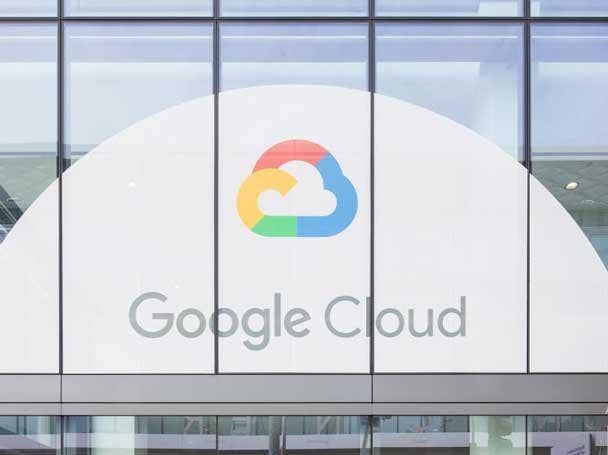
From Anthos on AWS to new technology solutions for retailers to enhanced Google Meet capabilities, Google Cloud has stepped up its product development this year to boost its hybrid and multi-cloud strategy and industry vertical focus and address new customer demands brought on by the coronavirus (COVID-19) pandemic.
Google Cloud’s new Anthos on AWS allows customers to run workloads on rival Amazon Web Services’ cloud. The No. 3-ranked cloud provider also added new functionality for the hybrid and multi-cloud Anthos platform, ranging from artificial intelligence (AI) and Kubernetes cluster management capabilities to bare metal support and deeper support for virtual machines (VMs).
Google Meet updates, which include an expanded tiled layout, a low-light mode, background noise cancellation and security enhancements, are designed to help organizations and educators use the real-time meeting and video conferencing solution with their remote workforces and e-learners during the pandemic.
“There has been an incredible amount of additional functionality that has been released in (Meet),” said Carolee Gearhart, vice president of worldwide channel sales and global SMB sales at Google Cloud. “At Next, we did announce the release of the hub of a much more fully integrated experience. There‘s tremendous traction and interest from partners.”
Google Cloud also is seeing increased activity with Google Cloud VMware Engine and its BigQuery enterprise data warehouse, according to Gearhart.
The new native Google Cloud VMware Engine is an integrated, first-party solution for customers to extend, migrate and run their VMware environments in Google Cloud. BigQuery Omni, released in July as part of Google Cloud’s multi-cloud strategy during its virtual Next ’20: OnAir conference, allows users to run the same database in multiple cloud and data center environments.
“It’s just an extension of the acceleration with BigQuery,” Gearhart said. “BigQuery has (had) an off-the-hook level of engagement…as customers are really grappling with data, and analytics now becoming so important to really understand what’s happening in a given market.”
Here’s a look at the Anthos updates, new Google Meet features, Google Cloud VMware Engine, BigQuery Omni and some of the other top new Google Cloud products –from Confidential VMs to a Cloud Healthcare API -- announced so far this year.
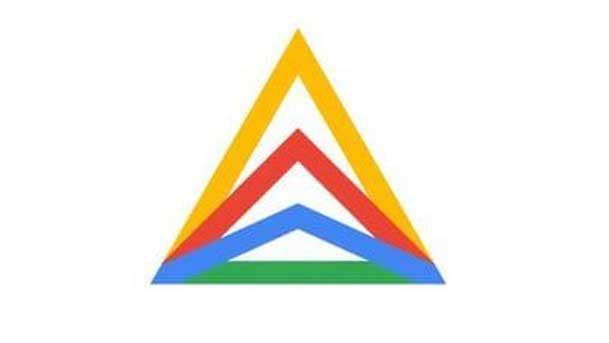
Anthos On AWS And Other New Platform Features
Google Cloud this year announced the general availability of Anthos on AWS, which allows customers to run workloads on rival AWS’ cloud, along with new functionality that includes AI and Kubernetes cluster management capabilities, deeper support for VMs and bare metal support for the hybrid and multi-cloud platform.
Anthos on AWS came in April, about one year after Google Cloud unveiled the Kubernetes-based Anthos at its Next ’19 conference in San Francisco. Anthos allows customers to build and manage applications across environments -- in their on-premises data centers, on Google Cloud and on rival third-party clouds. Google Cloud is testing Anthos on Microsoft Azure with customers.
Google Cloud’s deeper Anthos support for VMs is provided with Anthos Config Management, which allows users to extend Anthos’ management framework to the types of workloads that make up the majority of existing systems, according to Jennifer Lin, Google Cloud’s vice president of product management.
Google Cloud’s first hybrid AI product, Speech-to-Text On-Prem, allows for easy integration of Google speech-recognition technologies in users’ on-premises solutions. It became generally available this month through Google Marketplace, giving users complete control – from within their own data centers -- of speech data protected by data residency and compliance requirements. The machine learning (ML) technology leverages Google-developed speech recognition models that the cloud provider says are more accurate and smaller in size, and require fewer computing resources to run, than other solutions. The application can be deployed as a container to any Google Kubernetes Engine (GKE) or Anthos cluster.
New Anthos attached clusters allow users to manage any Kubernetes cluster with the Anthos control plane, including centralized management for configuration and service mesh capabilities. Attaching clusters allows users to view existing Kubernetes clusters in Anthos with their Anthos GKE clusters, and it enables a subset of Anthos features on them, including Anthos Service Mesh and Anthos Config Management. Current cluster types that can be attached to Anthos are Amazon Elastic Kubernetes Service (Amazon EKS) on Kubernetes version 1.16 and Microsoft Azure Kubernetes Service (Microsoft AKS) on Kubernetes version 1.16.
Google Cloud in March heralded Anthos for Telecom , which will bring the platform to the network edge, as part of its telecommunications industry strategy that includes helping telco companies monetize 5G as a business services platform.
Google Cloud and Hewlett Packard Enterprise (HPE) also made HPE GreenLake for Anthos generally available. The new service combines Google Cloud’s container hosting and management in hybrid and multi-cloud environments with HPE’s on-premises architecture.
And finally, Google Cloud developed a joint solution with NVIDIA, publicly available in beta, that allows customers to run NVIDIA GPU workloads on Anthos across hybrid cloud and on-premises environments.
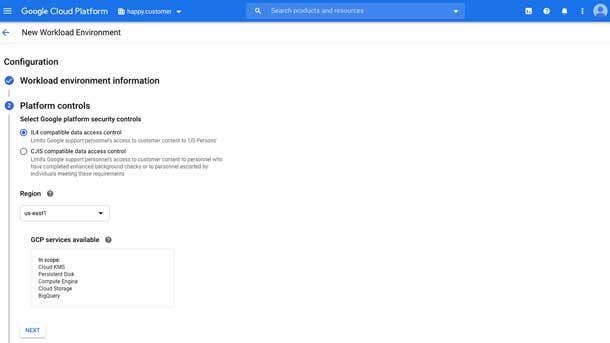
Assured Workloads For Government
Assured Workloads for Government, a new security tool, is designed to help customers serve their government workloads -- “without the compromises of traditional ‘government clouds’” and sacrificing functionality, according to Google Cloud.
It simplifies the compliance configuration process and provides seamless platform compatibility between government and commercial cloud environments, according to Christopher Johnson, a security and product manager at Google Cloud, and Bhavna Batra, a trust and compliance product marketing officer.
Now in private beta in Google’s U.S. cloud regions, Assured Workloads for Government lets customers automatically apply controls to their government workloads, making it easier to meet security and compliance requirements for processing government data, including those concerning U.S. data locations and personnel access.
“To meet these requirements, many cloud providers have built separate environments with standalone data centers to run government workloads,” Johnson and Batra wrote in a blog post in July, when Google Cloud released the tool as part of Next ’20: OnAir. “But these ‘government clouds’ don’t come with the technology and benefits that a modern commercial cloud provides and often require users to operate two distinct application and operation supply chains, adding cost, complexity and risk. We believe that compliance shouldn’t require compromising functionality or service availability.”
Assured Workloads for Government helps government customers, suppliers and contractors meet security and compliance standards set by the U.S. Department of Defense (IL4), the FBI’s Criminal Justice Information Services Division and the Federal Risk and Authorization Management Program (FedRAMP).
Features include automatic enforcement of data location to meet U.S. government compliance requirements by choosing to store data at rest in U.S. cloud regions, built-in security controls to reduce the risk of accidental misconfigurations, and automatic enforcement of product deployment locations. Customers also can limit Google support personnel access based on factors including citizenship, geographical access locations and background checks.
The product is slated to be generally available with beta features this fall. Assured Workloads Support, expected in the fourth quarter, will offer premium 24/7 support from a U.S. person in a U.S. location, with 15-minute target service-level objectives for priority-one cases, according to Google Cloud.
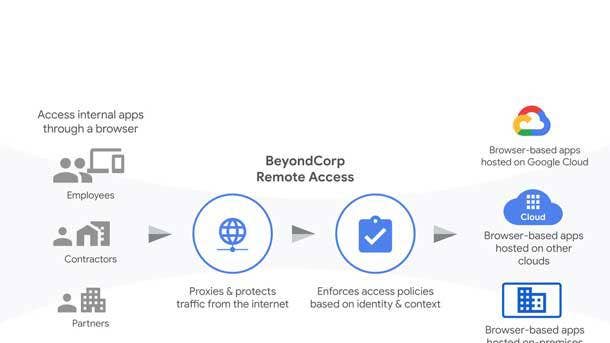
BeyondCorp Remote Access
BeyondCorp Remote Access allows organizations’ employees and extended workforce to access internal web applications -- customer service systems, call center applications, software bug trackers, project management dashboards, employee portals -- from almost any device, without a traditional remote-access virtual private network, while protecting their data.
The cloud identity and security solution, introduced in April in partnership with Google Cloud partners Deloitte Consulting and SADA Systems, came as organizations were dealing with new work-from-home requirements due to the pandemic. BeyondCorp refers to Google Cloud’s zero-trust access approach that it started pursuing in 2011 to allow its own employees to work from untrusted networks on a variety of devices without using a client-side VPN.
BeyondCorp Remote Access allows organizations’ employees, contractors and partners to access browser-based apps hosted on premises, on Google Cloud and on other clouds. It protects traffic from the internet and enforces access policies based on identity and context.
“Over time, we plan to offer the same capability, control and additional protections for virtually any application or resource a user needs to access,” Sunil Potti, vice president and general manager of Google Cloud, and Sampath Srinivas, director of product management at Google Cloud, wrote in a blog post in April.
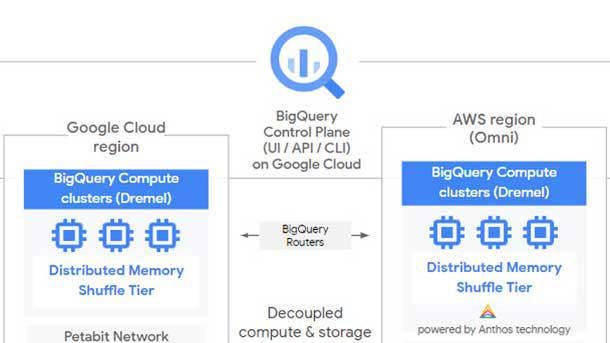
BigQuery Omni
Google Cloud’s BigQuery Omni is a new multi-cloud analytics solution, powered by its Anthos platform, that allows users to run the same database in multiple cloud and data center environments.
BigQuery Omni gives users the ability to run Google Cloud’s popular BigQuery serverless data warehouse to analyze data from the AWS and Microsoft Azure clouds. Google Cloud disclosed the new tool in July as part of its multi-cloud strategy during Next ’20: OnAir.
“From just BigQuery‘s user interface, you can now query data in Amazon and Azure without having to move that data to Google Cloud,” Google Cloud CEO Thomas Kurian said at the time. “So you can bring the power of BigQuery analytics to where your data sits without having to pay expensive egress fees in moving that data from other cloud providers to Google.”
The new solution extends Google Cloud’s analytics platform to other public clouds without leaving the BigQuery user interface and without having to move or copy datasets. It’s available in private alpha for AWS’ Amazon Simple Storage Service (S3), with support for Microsoft Azure coming soon.
Customers can use standard SQL and the same Big Query APIs to break down silos, analyze data in the same region where it’s stored and gain business insights from one pane of glass, according to the company.
The cost of moving data between cloud providers isn’t sustainable for many businesses, and it’s still difficult to seamlessly work across clouds, according to Debanjan Saha, Google Cloud’s general manager and vice president of engineering for data analytics.
“BigQuery Omni represents a new way of analyzing data stored in multiple public clouds, which is made possible by BigQuery‘s separation of compute and storage,” Saha wrote in a blog post about the solution. “By decoupling these two, BigQuery provides scalable storage that can reside in Google Cloud or other public clouds and stateless resilient compute that executes standard SQL queries. Until now, though, in order to use BigQuery, your data had to be stored in Google Cloud.”
BigQuery Omni supports the Avro, CSV, JSON, ORC and Parquet data file formats.
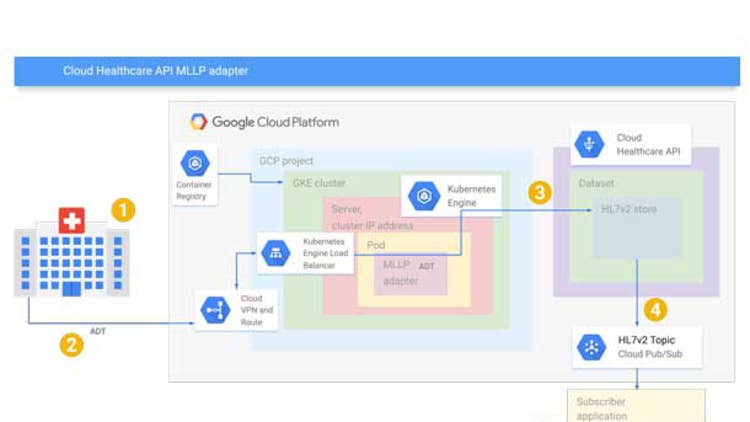
Cloud Healthcare API
Google Cloud released its Cloud Healthcare API for general consumption by the healthcare industry at-large in April to enable access to real-time healthcare data and aid its fight against the coronavirus crisis while meeting industry security, privacy and compliance requirements.
The Cloud Healthcare API, which allows for easy and standardized data exchange between healthcare applications and solutions built on Google Cloud, includes support for healthcare data standards including HL7 FHIR, HL7 v2 and DICOM. It provides a fully managed, enterprise-grade development environment for building clinical and analytics solutions on Google Cloud.
“The API allows healthcare organizations to ingest and manage key data from a range of inputs and systems and then better understand that data through the application of analytics and machine learning in real time, at scale,” according to a blog post by Dr. Joe Corkery, Google Cloud’s director of healthcare and life sciences product, and Aashima Gupta, director of healthcare and life sciences industry solutions. “It also enables providers to easily interact with that data using web-friendly, REST-based endpoints and health plans to rapidly get up and running, with a cloud-based FHIR server providing the capabilities needed to implement, scale and support interoperability and patient access.”
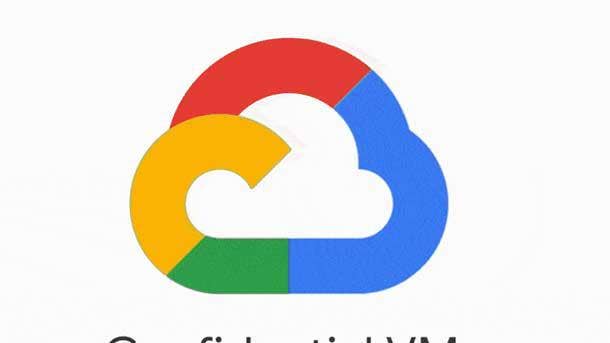
Confidential VMs
New Confidential VMs allow users to run workloads in Google Cloud while ensuring their data is encrypted when it’s in use and being processed, not just at rest and in transit. It’s Google Cloud’s first solution in its new confidential computing portfolio.
“Confidential computing allows you, as a customer, to run workloads in Google Cloud and to ensure that data is not only encrypted at rest and in transit, but it‘s even encrypted while it’s being processed,” Kurian said during Next ’20: OnAir in July. “This gives you the ability to ensure that all your data is protected all the time when it is being processed with Google.”
Available in beta for Google Compute Engine, the solution helps remove cloud adoption barriers for customers in highly regulated industries, according to Kurian.
“Rarely do new technologies emerge that can fundamentally change the nature of cloud computing,” Vint Cerf, Google’s chief internet “evangelist,” said in a statement. “Confidential Computing is one of those game-changers that has the potential to transform the way organizations process data in the cloud while significantly improving confidentiality and privacy.”
Confidential computing environments keep data encrypted in memory and elsewhere outside the central processing unit (CPU).
“We already employ a variety of isolation and sandboxing techniques as part of our cloud infrastructure to help make our multi-tenant architecture secure,” Google Cloud senior product manager Nelly Porter, confidential computing engineering director Gilad Golan and Sam Lugani, lead security product marketing manager for G Suite and the Google Cloud Platform (GCP), said in a joint blog post. “Confidential VMs take this to the next level by offering memory encryption, so that you can further isolate your workloads in the cloud.”
Confidential computing can unlock computing scenarios that have previously not been possible, according to the trio, and organizations now can share confidential data sets and collaborate on research in the cloud while preserving confidentiality.
The Confidential VMs are based on Google Cloud‘s N2D series instances and leverage AMD’s Secure Encrypted Virtualization feature supported by its 2nd Gen AMD EPYC CPUs. Dedicated per-VM encryption keys are generated in hardware and are not exportable.
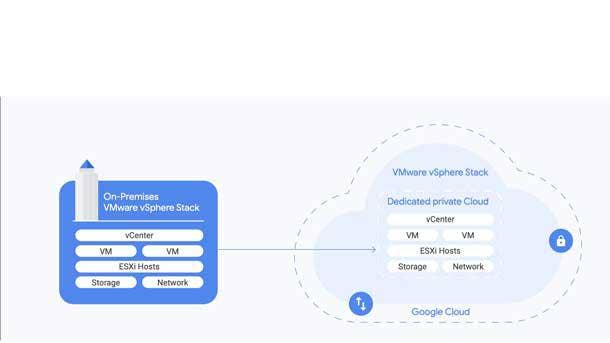
Google Cloud VMware Engine
Google Cloud VMware Engine -- an integrated, first-party solution to lift, shift and run VMware-based applications natively in Google Cloud without refactoring or rewriting them -- became generally available in late June.
The new service, which bolsters the No. 3 cloud provider’s enterprise push under Kurian, provides a fully managed VMware Cloud Foundation stack, including vSphere, vCenter, vSAN, NSX-T and HCX, in a dedicated environment on Google Cloud’s infrastructure for enterprise production workloads.
Customers can migrate or extend their on-premises workloads to Google Cloud by connecting to a dedicated VMware environment directly through the Google Cloud Console. Google Cloud VMware Engine allows them to provision a VMware software-defined data center (SDDC) with a few clicks and have a fully functional SDDC directly from the Google Cloud Console about 30 minutes later, June Yang, general manager of Google Cloud’s compute business, told CRN in a May interview. The VMware environments can be provisioned using customers’ existing Google Cloud identities.
“As we look at many enterprises, they have a fairly sizable VMware on-premise environment to power their various type of applications, from ERP (enterprise resource planning) to CRM (customer relationship management) to databases, etc.,” Yang said in the CRN interview. “We want to make this really easy for customers to be able to migrate these workloads…to the cloud with really minimal change, so that they can focus on running their applications without managing their overall infrastructure.”
The service, which is fully owned, operated and supported by Google Cloud, is available in Google Cloud’s U.S.-East4 (Ashburn, Va.) and U.S.-West2 (Los Angeles) regions, and is expected to be expand to additional regions this year.
In July 2019, Google Cloud had announced early customer access to Google Cloud VMware Solution by CloudSimple, a startup focused on helping VMware customers to easily migrate workloads to the cloud. The VMware-as-a-service offering leveraged VMware Cloud Foundation running on the Google Cloud Platform (GCP) and was listed on the GCP Marketplace late last year. Google Cloud then acquired CloudSimple in November for an undisclosed sum.
“Essentially we have taken the CloudSimple technology and enhanced it, and made it native to Google Cloud, so now it‘s a first-party service offering that’s really operated and run by Google,” said Yang, who spent about 10 years at VMware, where she ran vSphere product management and later was also part of the VMware Cloud on AWS effort.
The integrated offering gives customers access to Google Cloud services including Anthos, BigQuery, Cloud AI, its operations suite and Google Cloud Storage.
“It’s really about enjoying the cloud infrastructure benefits while leveraging the existing assets and existing tooling and training they‘ve already had,” Yang said. “A customer can take the application and, if they so choose to, they can modernize in place with Google and also…extend to additional services that really allow them to drive more value and insights out of the application.”
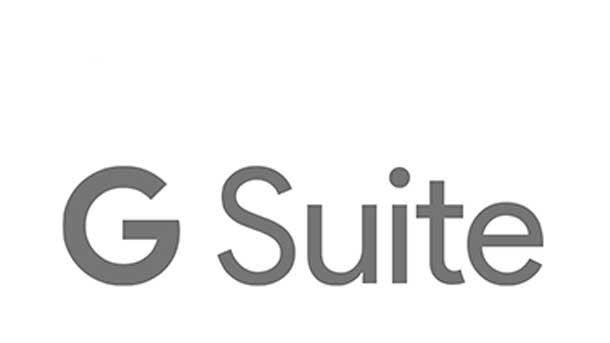
G Suite Updates
Google Cloud has made numerous improvements to G Suite, its suite of cloud-based collaboration and productivity apps that includes Gmail, Docs, Drive, Calendar and Meet.
Google Meet has experienced rapidly growing use due to the rise in remote workers during the coronavirus pandemic. Since March, Google Cloud has been allowing all G Suite and G Suite for Education customers to use Google Meet’s advanced video-conferencing capabilities for free, an offer than runs through Sept. 30.
Four new Google Meet features issued in April were among the top-requested changes for the real-time meeting and video conferencing solution, according to Google Cloud. An expanded tiled layout allows 16 participants at a time to be visible along with content that’s being shared, and Google Cloud is working to boost that number to 49 in September. Google Cloud also provided the option to present a Chrome tab for sharing higher-quality video content with audio; a low-light mode powered by AI that automatically adjusts users’ videos in less-than-optimal lighting; and a noise cancellation capability that filters out background noises for G Suite Enterprise and G Suite Enterprise for Education customers.
In late June, Google Cloud announced that Google Meet is available on the Nest Hub Max smart display and plans -- designed to make it easier to conduct large enterprise-grade meetings -- for new capabilities that allow participants to “raise their hands” when they want to speak or have a question and allow hosts to look at meeting attendance. Users also will be able to split larger meetings into smaller groups in “breakout rooms,” get a channel for audience questions without interrupting the meeting flow and do real-time polling of meeting participants. In addition, meeting hosts will get additional controls, including for muting, presenting and joining meetings.
As part of its “better home for work” in G Suite initiative unwrapped last month, Google Cloud also said it was integrating workplace tools such as video, chat, email, files and tasks.
The cloud provider also brought Google Meet into Gmail on the web and Android and iOS devices to make it easy for users to join meetings from their email inboxes. It brought Google Chat into Gmail on the web with plans for doing the same for Gmail on Android and iOS devices. Google Cloud also added shared files and tasks to Chat rooms, where users now can open and co-edit documents with their teams without switching screens and leaving Gmail, and it expanded Gmail’s search capability to include Chat.
Other new tools help users pin important rooms so they’re easier to find, set their availability to “do not disturb” and include status notices such as “out of the office.” The improvements also enable easier access to third-party apps such as DocuSign, Salesforce and Trello within Gmail, Chat and Chat rooms.
“One thing we’ve heard again and again from our users is how switching between apps interrupts their flow -- and their focus,” Javier Soltero, vice president and general manager of G Suite, said in a July blog post. “That’s why, in this new integrated experience, we’ve been thoughtful about how to help you work more fluidly. A few examples: You can quickly join a video call from a chat, forward a chat message to your inbox, create a task from a chat message -- everything connects together in a way that makes it easy for you to manage the flow of your work and get more done.”
Picture-in-picture video calls from Gmail and the integration of Google Meet into content tools including Docs, Sheets and Slides are in the works.
Google Cloud also revealed several new security features for Google Meet and Google Chat. For Google Meet, if an attendee is ejected from a meeting, they won’t be able to rejoin by “knocking” unless the hosts invites them again. If a knocking request has been denied multiple times, that user will be automatically be prohibited from sending additional requests to join the meeting. Hosts also can decide which attendees can chat or present in a meeting with safety locks that also allow them to decide which methods of joining – a calendar invite or phone, for example, require users to have explicit approval. Safety locks will block anonymous users – those not logged into a Google account – from attempting to join a meeting, and they will enforce the requirement that a host must join first.
In addition, phishing protections built into Gmail have been extended to Google Chat, so if a user clicks on a link in Chat, that link will be scanned in real time and checked against data from Google’s Safe Browsing product and flagged if it contains malicious content.
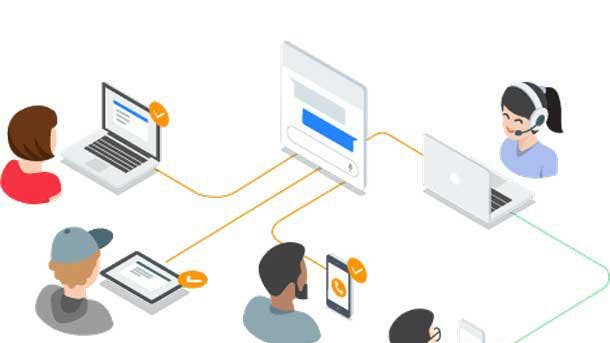
Rapid Response Virtual Agent
Google Cloud released Rapid Response Virtual Agent to augment its Contact Center AI customer service solution in April.
The new tool, available for chat and voice bots, allows customers to quickly build and deploy a customized Contact Center AI virtual agent to respond to customer questions via chat, phone and social media channels in 23 languages supported by the Dialogflow natural language understanding platform.Rapid Response Virtual Agents
Google Cloud said it’s seen a lot of retail-, coronavirus- and unemployment system-related use cases for the new technology, which is designed to reduce customer hold times and alleviate pressure on contact centers, allowing human agents to handle more complex cases. Google Cloud has a COVID-19 virtual agent template from sister company Verily that sets up a virtual agent to conduct screenings and answer frequently asked questions based on the latest guidance from the U.S. Centers for Disease Control.
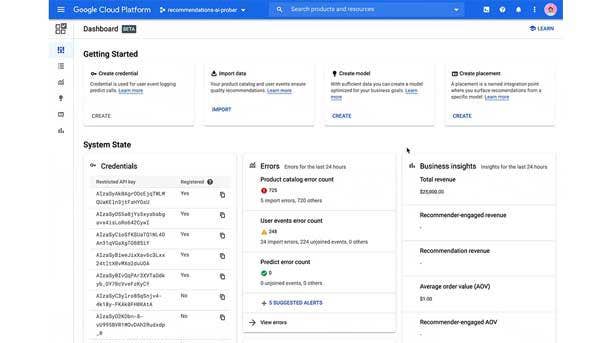
Recommendations AI
Recommendations AI allows retailers to personalize their services by offering, with low latency, highly personalized product recommendations that match their online customers’ preferences. It uses Google’s ML capabilities and adapts in real time to customer behavior and changing retail variables such as assortments, pricing and special offers.
The fully managed service, publicly available in beta to all customers as of July, draws on Google’s experience delivering recommendations for its products including YouTube, Google Search and Google Ads, according to Pallav Mehta, a cloud AI product manager at Google Cloud.
“By putting a greater emphasis on each individual customer rather than on an item, Recommendations AI is able to piece together the history of a customer’s shopping journey and serve them with personalized product recommendations,” Mehta said in a blog post. “Recommendations AI also excels at handling recommendations in scenarios with long-tail products and cold-start users and items. Its ‘context hungry,’ deep learning models use item and user metadata to draw insights across millions of items at scale and constantly iterate on those insights in real time in a way that is impossible for manually curated rules to keep up with.”
Retail is one of six industries that Google Cloud is targeting with tailored, industry-specific vertical solutions.